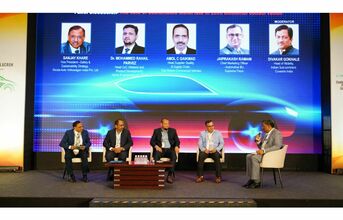
Secondly, the government has expanded the producer's responsibility, meaning that both users and producers are obligated to manage the entire life cycle of specific aggregates. It's not just about producing assets; they must also be appropriately tagged, traced, and tracked until disposal. Currently, this requirement applies to a limited set of aggregates, like batteries and plastic packaging. However, as the scope broadens to include ferrous and non-ferrous materials and other components, the responsibility of the ecosystem will increase. Whether it's on the demand or supply side, the entire ecosystem will bear a greater responsibility.
Divakar then directed the discussion towards Parvaiz and Ramani, initiating a conversation about their activities in this domain.
Parvaiz articulated that Varroc has a well-defined strategy focused on the sustainability and reusability of plastics. He highlighted the projection that 60 per cent of emissions by 2040 will stem from materials alone, prompting the initiation of two ongoing projects. In one project, a biomaterial derived from coffee shells has been incorporated into polypropylene (PP) to replace the Ford housing, and it is currently in production. Additionally, this year, Varroc is set to launch another project that involves using natural fibre as a substitute for talc.
This provides a significant benefit of a 20 per cent reduction in weight, and it was discovered that the processing temperature of this material is over 40 per cent lower than that of conventional materials. This covers both energy consumption and CO2 emissions.
There are two approaches to sustainability, that he shared, particularly in terms of materials. The first involves introducing biomaterials, which is a straightforward method. The second entails using recycled content and avoiding single-use materials. He urged that the responsibility for sustainability is not solely that of tier 1; it requires collaboration from raw material suppliers, tier 1 suppliers, and OEMs.
Speaking about Supreme Group, Ramani shared that they not only serve the automotive sector as a component supplier, but they are also backward integrated. Supreme handles their own materials, even going as far as processing their own fibres.
They implemented a four-pronged strategy, which they refer to as ‘better by design, better by materials, better by performance, and better by end of life.' To elaborate, their designs aim to embody a zero-waste mentality.
Advancing with better materials involves the use of renewed and repurposed materials. Additionally, when discussing improvements in the end-of-life phase, he pointed out that they are looking at their peers and have initiated the development of an ecosystem to reintegrate products into a domain where materials can be extracted for reuse.
The conversation then shifted to how individuals in the Tier 1 sector operate in this field and whether they always wait for an OEM directive before taking action.
Ramani responded, stating that as tier-one suppliers, they naturally view OEMs as significant influencers, often adopting a "big brother" approach and expecting them to take the lead. Nevertheless, he acknowledged that in sustainability initiatives, there is always a need to strike a delicate balance between environmental considerations, economic factors, and social responsibility. Achieving this balance proves to be a challenging task for tier-one suppliers.
However, he did mention that they do try to share their insights from a product perspective during discussions, and there is a mutual interest in exploring potential implementations. It is a two-way communication.
Continue Reading on Page 3



































